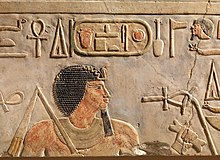
Back Amenemhat I Afrikaans 1 አመነምሃት Amharic أمنمحات الأول Arabic امنمحات الاول ARZ I Amenemhet Azerbaijani Аменемхет I Byelorussian Аменемхет I Bulgarian Amenemhet I Catalan Amenemhet I. Czech Аменемхет I CV
- See Amenemhat, for other individuals with this name.
| Amenemhat I | |||||||||||||||||||||||||||||||||||||||||||||||||||||||||||||||||||||||||||||||||||||||||||||||||||||||||||||||||||||||||||||||||||||||||||||
|---|---|---|---|---|---|---|---|---|---|---|---|---|---|---|---|---|---|---|---|---|---|---|---|---|---|---|---|---|---|---|---|---|---|---|---|---|---|---|---|---|---|---|---|---|---|---|---|---|---|---|---|---|---|---|---|---|---|---|---|---|---|---|---|---|---|---|---|---|---|---|---|---|---|---|---|---|---|---|---|---|---|---|---|---|---|---|---|---|---|---|---|---|---|---|---|---|---|---|---|---|---|---|---|---|---|---|---|---|---|---|---|---|---|---|---|---|---|---|---|---|---|---|---|---|---|---|---|---|---|---|---|---|---|---|---|---|---|---|---|---|---|
| Ammenemes I | |||||||||||||||||||||||||||||||||||||||||||||||||||||||||||||||||||||||||||||||||||||||||||||||||||||||||||||||||||||||||||||||||||||||||||||
 Relief of Amenemhat I from his pyramid complex at El-Lisht | |||||||||||||||||||||||||||||||||||||||||||||||||||||||||||||||||||||||||||||||||||||||||||||||||||||||||||||||||||||||||||||||||||||||||||||
| Pharaoh | |||||||||||||||||||||||||||||||||||||||||||||||||||||||||||||||||||||||||||||||||||||||||||||||||||||||||||||||||||||||||||||||||||||||||||||
| Reign | 29 years according to the Turin Canon but at least 30 years, in the 20th century BC.[1][a] | ||||||||||||||||||||||||||||||||||||||||||||||||||||||||||||||||||||||||||||||||||||||||||||||||||||||||||||||||||||||||||||||||||||||||||||
| Predecessor | Mentuhotep IV | ||||||||||||||||||||||||||||||||||||||||||||||||||||||||||||||||||||||||||||||||||||||||||||||||||||||||||||||||||||||||||||||||||||||||||||
| Successor | Senusret I | ||||||||||||||||||||||||||||||||||||||||||||||||||||||||||||||||||||||||||||||||||||||||||||||||||||||||||||||||||||||||||||||||||||||||||||
| |||||||||||||||||||||||||||||||||||||||||||||||||||||||||||||||||||||||||||||||||||||||||||||||||||||||||||||||||||||||||||||||||||||||||||||
| Consort | Neferitatjenen | ||||||||||||||||||||||||||||||||||||||||||||||||||||||||||||||||||||||||||||||||||||||||||||||||||||||||||||||||||||||||||||||||||||||||||||
| Children | Senusret I, Neferu III, Neferusherit, Kayet | ||||||||||||||||||||||||||||||||||||||||||||||||||||||||||||||||||||||||||||||||||||||||||||||||||||||||||||||||||||||||||||||||||||||||||||
| Father | Senusret | ||||||||||||||||||||||||||||||||||||||||||||||||||||||||||||||||||||||||||||||||||||||||||||||||||||||||||||||||||||||||||||||||||||||||||||
| Mother | Neferet | ||||||||||||||||||||||||||||||||||||||||||||||||||||||||||||||||||||||||||||||||||||||||||||||||||||||||||||||||||||||||||||||||||||||||||||
| Burial | Pyramid at el-Lisht | ||||||||||||||||||||||||||||||||||||||||||||||||||||||||||||||||||||||||||||||||||||||||||||||||||||||||||||||||||||||||||||||||||||||||||||
| Dynasty | Twelfth Dynasty | ||||||||||||||||||||||||||||||||||||||||||||||||||||||||||||||||||||||||||||||||||||||||||||||||||||||||||||||||||||||||||||||||||||||||||||

Amenemhat I (Ancient Egyptian: Ỉmn-m-ḥꜣt meaning 'Amun is at the forefront'), also known as Amenemhet I, was a pharaoh of ancient Egypt and the first king of the Twelfth Dynasty of the Middle Kingdom.
Amenemhat I was probably the same as the vizier named Amenemhat who led an expedition to Wadi Hammamat under his predecessor Mentuhotep IV, and possibly overthrew him from power.[14] Scholars differ as to whether Mentuhotep IV was killed by Amenemhat I, but there is no independent evidence to suggest this and there may even have been a period of co-regency between their reigns.[15]
Amenemhat I was not of royal lineage, born to Senusret and Nefert who were possibly related to the nomarchial family of Elephantine.[16] The composition of some literary works (the Prophecy of Neferti,[17] the Instructions of Amenemhat[18]) and, in architecture, the reversion to the pyramid-style complexes of the 6th dynasty rulers are often considered to have been attempts at legitimizing his rule. Texts from the period mention his mother being from the Upper Egyptian nome Ta-Seti. Many scholars in recent years have argued that Amenemhat I's mother was of Nubian origin.[19][20][21]
Amenemhat I moved the capital from Thebes to Itjtawy and was buried in el-Lisht. He may have been assassinated.
- ^ Schneider 2006, p. 174.
- ^ Dodson & Hilton 2004, p. 288.
- ^ Grimal 1992, p. 391.
- ^ Clayton 1994, p. 78.
- ^ Franke 2001, p. 68.
- ^ Lehner 2008, p. 8.
- ^ Shaw 2003, p. 483.
- ^ Oppenheim et al. 2015, p. xix.
- ^ Krauss & Warburton 2006, p. 491.
- ^ Grajetzki 2006, p. 28.
- ^ a b c d e Leprohon 2013, p. 57.
- ^ a b c d e f g h von Beckerath 1984, p. 197.
- ^ a b c Leprohon 2013, p. 58.
- ^ Stiebing, William H. (2016) [2009]. Ancient Near Eastern History and Culture (2nd ed.). London; New York: Routledge. p. 156. ISBN 978-0-321-42297-2. OCLC 1004426779. Retrieved June 21, 2020.
- ^ E. Hornung, History of Ancient Egypt, 1999 p.50
- ^ "Amenemhat I Sehetibre | Ancient Egypt Online". Retrieved 2020-10-13.
- ^ M. Lichtheim, Ancient Egyptian Literature, 1973 p.139
- ^ M. Lichtheim, Ancient Egyptian Literature, 1973 p.135
- ^ General History of Africa Volume II - Ancient civilizations of Africa (ed. G Moktar). UNESCO. p. 152.
- ^ Lobban, Richard A. Jr. (10 April 2021). Historical Dictionary of Ancient Nubia. Rowman & Littlefield. ISBN 9781538133392.
- ^ Van de Mieroop, Marc (2021). A history of ancient Egypt (Second ed.). Chichester, West Sussex. p. 99. ISBN 978-1119620877.
{{cite book}}: CS1 maint: location missing publisher (link)
Cite error: There are <ref group=lower-alpha> tags or {{efn}} templates on this page, but the references will not show without a {{reflist|group=lower-alpha}} template or {{notelist}} template (see the help page).
